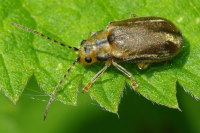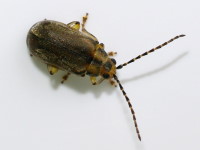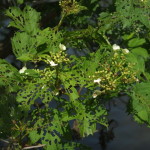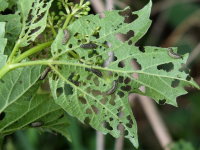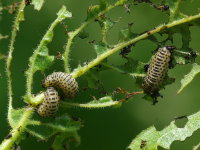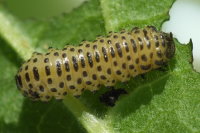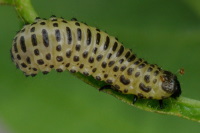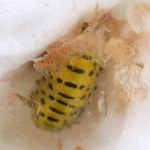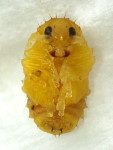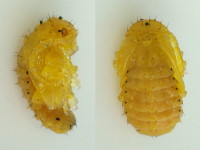Phylum Arthropoda (Arthropods) ➔ Subphylum Hexapoda (Hexapods) ➔ Class Insecta (Insects) ➔ Order Coleoptera (Beetles) ➔ Family Chrysomelidae (Leaf beetles)
Pyrrhalta viburni (Paykull, 1799)
Schneeball-Blattkäfer Viburnum Leaf Beetle
Synonyms and other combinations:
Galeruca viburni Paykull, 1799 | Pyrrhalta nigrescens Ochs, 1925 | Adimonia verna Laicharting, 1781 |
Classification:
Pyrrhalta viburni belongs to the subfamily Galerucinae, tribe Galerucini.Distribution:
Europe (missing in the Balkans), east to the Urals and Siberia, introduced into North America.Habitat:
On Viburnum species in deciduous forests, parks, gardens, bushes and forest margins.Description:
Length 4.5 - 6.5 mm; body brownish yellow; upper side matt chagrinated with very fine, dense puncture; wing covers arched with well marked humeral fold; head almost as broad as the pronotum; antennae slender, the tip segments three times longer than broad; 3rd antennal segment longer than the 4th; pronotum blackened at the sides; puncture on the pronotum almost invisible.Pyrrhalta viburni is the only species of the genus Pyrrhalta in Europe.
Biology:
The Viburnum Leaf Beetle Pyrrhalta viburni forms one generation per year. The beetles are macropter and able to fly, but rarely fly.The species lives on Viburnum (Adoxaceae), often on Guelder-rose (Viburnum opolus), more rarely on wayfaring tree (Viburnum lantana), and on many Viburnum cultivars.
Pyrrhalta viburni hibernates in the egg stage. The larvae hatch at the earliest at the end of April, as soon as the leaves of the host plant sprout. The larvae feed on the underside of the leaves. From May onwards, the larvae go into the ground to pupate. The new generation hatches after 10 to 30 days at the end of June or beginning of July. The entire development takes about 8 - 10 weeks. The beetles eat holes in the leaves and mate about 2 weeks after hatching. Shortly after, the females start laying eggs. The eggs are laid in small groups of 5 - 10 pieces into previously gnawed deep holes in the twigs. The egg pits are then closed with a mixture of faeces, gnawed plant parts and slime. Each female can lay up to 500 eggs into up to 50 holes. The adults can be found until the end of October. The eggs winter.
References, further reading, links:
- Rheinheimer, Joachim, & Hassler, Michael: Die Blattkäfer Baden-Württembergs, 2018, 928 pages, Kleinsteuber Books (Karlsruhe), ISBN 978-3-9818110-2-5
- Arved Lompe: Die Käfer Europas - Ein Bestimmungswerk im Internet
- Altica sp.
- Bruchus sp.
- Cassida nebulosa
- Cassida sp.
- Cassida stigmatica
- Cassida vibex
- Cassida vibex/bergeali
- Chrysolina lucidicollis
- Chrysolina oricalcia
- Chrysolina sp.
- Chrysolina sturmi
- Chrysolina varians
- Chrysomela tremula
- Coptocephala sp.
- Crepidodera aurea
- Crepidodera fulvicornis
- Cryptocephalus moraei
- Cryptocephalus nitidus
- Cryptocephalus pusillus
- Cryptocephalus sp.
- Donacia cinerea
- Donacia marginata
- Donacia versicolorea
- Galeruca tanaceti
- Galerucella s.l.
- Gonioctena decemnotata
- Gonioctena quinquepunctata
- Gonioctena sp.
- Gonioctena viminalis
- Lema cyanella
- Neocrepidodera sp.
- Oulema melanopus/duftschmidi
- Oulema obscura
- Pachybrachis sp.
- Phratora sp.
- Plagiosterna aenea
- Plateumaris sp.
- Podagrica fuscicornis
- Psylliodes sp.
- Sphaeroderma sp.
- Gonioctena quinquepunctata/intermedia
- Alder Leaf Beetle
- Ant Bag Beetle
- Barley Flea Beetle
- Brassy Willow Leaf Beetle
- Broad Bean Weevil
- Case-bearing Leaf Beetles
- Colorado Potato Beetle
- Dead-nettle Leaf Beetle
- Elm Leaf Beetle
- Four Spotted Leaf Beetle
- Green Dock Beetle
- Green Tortoise Beetle
- Horseradish Flea Beetle
- Imported Willow Leaf Beetle
- Iris Flea Beetle
- Lily Leaf Beetle
- Plantain Leaf Beetle
- Poplar Leaf Beetle
- Skullcap Leaf Beetle
- Spotted Asparagus Beetle
- Spotted Willow Leaf Beetle
- St John's-wort Leaf Beetle
- Thistle Tortoise Beetle
- Turnip Flea Beetle
- Two-tone Reed Beetle
- Viburnum Leaf Beetle
- Western Grape Rootworm
- Wheat Flea Beetle
- Willow Flea Beetle
- Willow Leaf Beetle
